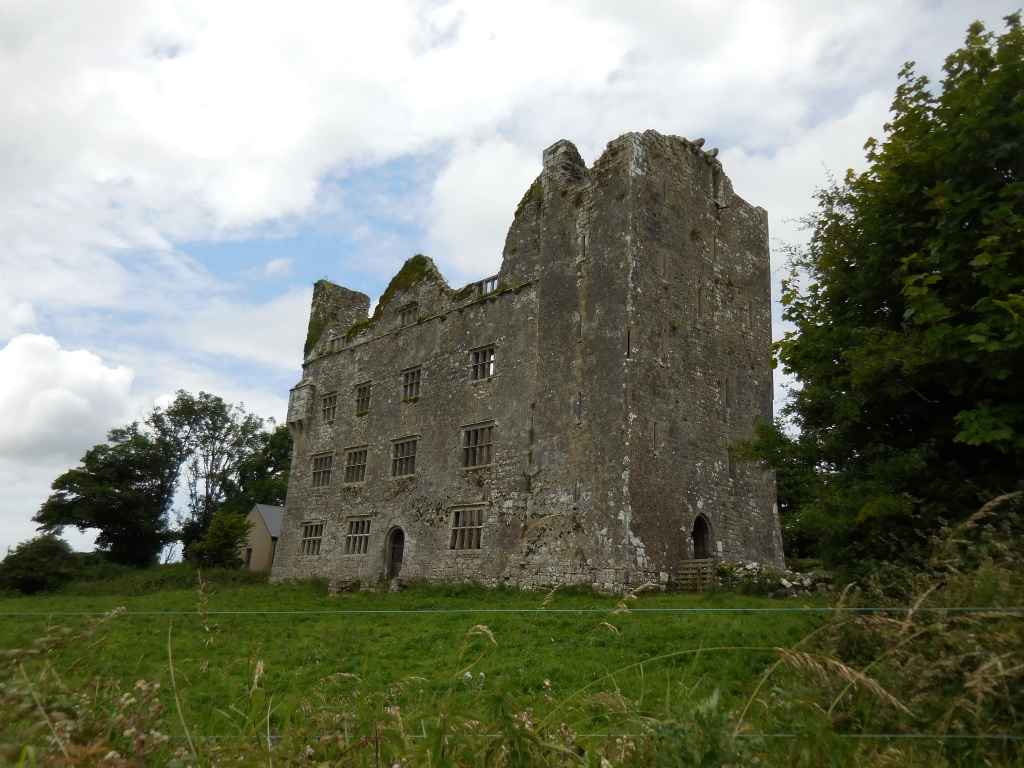Leamaneh Burg / Leamaneh Castle
Leamaneh Castle wurde im späten 15. Jahrhundert vom Clan der O'Brien als einfacher Wohnturm erbaut. Murrough O'Brien unterwarf sich 1543 Heinrich VIII. und durfte seine Besitztümer behalten. 1639 heiratet sein Urenkel Conor O'Brien Mary MacNamara (Máire Nic Mhathúna), die zu einer der berüchtigtsten Frauen in der Folklore der Insel wurde. Die beiden ließen den Wohnturm zu einem vierstöckigen Haus erweitern. Nach dem Tod von Conor heiratet Mary Cornet John Cooper, einen Soldaten im Dienste Cromwells, um weiterhin im Haus wohnen zu können. Ihr Sohn Donagh verlegte 1685 den Familienwohnsitz nach Dromoland Castle. In Leamaneh Castle lebten danach noch mehrere Bewohner, es verfiel aber bis zum Ende des 18. Jahrhunderts.
Mary MacNamara, die auch die "Rote Maria" (Máire Rua) genannt wurde, werden unsägliche Grausamkeiten nachgesagt. Sie kam auch gewaltsam ums Leben und ihr Geist soll noch heute im Haus und der Gegend herum spuken.
Leamaneh Castle was built in the late 15th century by the Clan O'Brien as a simple tower house. Murrough O'Brien bowed to Henry VIII. in 1543 and was allowed to keep his possessions. In 1639 his great-grandson Conor O'Brien married Mary MacNamara (Máire Nic Mhathúna), who became one of the most infamous women in the folklore of the island. The couple had the tower house enlarged to a four-story house. After Conor's death Mary married Cornet John Cooper, a soldier in the service of Oliver Cromwell, to be able to continue living in the house. Her son Donagh moved the family residence to Dromoland Castle in 1685. Afterwards several occupants lived in Leamaneh Castle, but it deteriorated until the end of the 18th century.
Rumours were told that Mary MacNamara, who was also called "Red Mary" (Máire Rua), had done unspeakable cruelties. She lost her live by violence, too, and her ghost is purported to haunt the house and its surroundings.
Zugeordnete Themen / Assigned Topics:
Mehr Informationen über - Leamaneh Burg / More information about - Leamaneh Castle
- carpediemeire.com/2020/10/20/leamaneh-castle-and-the-notorious-red-mary/
- Wikipedia (en): Leamaneh Castle
- www.archiseek.com/2009/lemenagh-castle-co-clare/
- www.irish-expressions.com/leamaneh-castle.html
- www.irishhistory.com/architecture-and-monuments/castles/a-dive-into-the-history-of-leamaneh-castle-co-clare-ireland/
- www.majestic-castles-in-ireland.com/leamaneh-castle.html
- www.theirishplace.com/heritage/red-mary-ghost-leamaneh-castle/
Lage / Location
- Irish grid: R 23500 93576
Historischer Verweis / Historic Reference
(© Wiki Commons)
- BC
- Ballycasheen Ganggrab / Ballycasheen Portal Tomb
- BG
- Ballygriffy Burg / Ballygriffy Castle
- BL
- Ballyganner Süd Keildolmen / Ballyganner South Wedge Tomb
- BN
- Ballinalackan Burg / Ballinalackan Castle
- BP
- Ballyportry Burg / Ballyportry Castle
- BU
- The Burren
- BY
- Ballyshanny Ringfort
- CF
- Corofin
- CG
- Cahergrillaun Dolmen / Cahergrillaun Tomb
- CL
- Caherconnell Ringfort
- CM
- Cahercommaun Ringfort
- CM
- Cahermacnaughten Ringfort
- CN
- Carran Kirche / Carran Church
- CS
- Corkscrew Hill
- CT
- Castletown Burg / Castletown Castle
- CU
- Calluragh Süd Dolmen / Calluragh South Megalithic Tomb
- CV
- Creevagh Keildolmen / Creevagh Wedge Tomb
- CW
- Caherminnaun West Dolmen / Caherminnaun West Megalithic Tomb
- DY
- Dysert O'Dea
- ET
- Ennistimon
- GI
- Gleninsheen Keildolmen / Gleninsheen Wedge Tomb
- IL
- Inchiquin Lough
- KB
- Killinaboy
- KC
- Kilcorney Kirche / Kilcorney Church
- KF
- Kilfenora
- KG
- Killonaghan Kirche / Killonaghan Church
- LE
- Lahinch
- LV
- Lisdoonvarna
- NV
- Noughaval
- PB
- Poulnabrone Dolmen
- PN
- Parknabinnia Keilgrab / Parknabinnia Wedge Tomb
- PP
- Poulaphuca Keildolmen / Poulaphuca Wedge Tomb
- RT
- Rath Kirche / Rath Church
- RU
- Ruan
- TE
- Temple Cronan Church







